Overseas Theater of the Seven Years' War. Quebec Fall
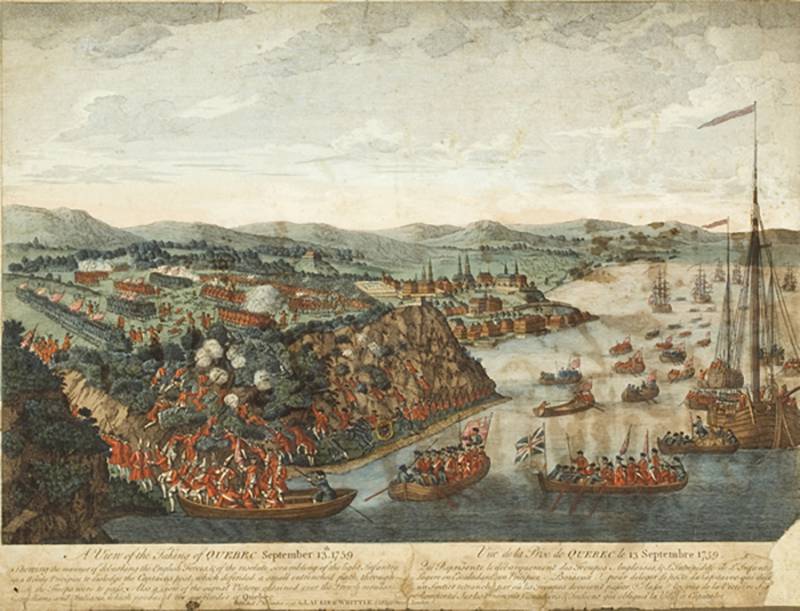
The commander who was carried away from the field of the lost battle was followed by different people: tired soldiers in dusty uniforms and dirty wigs from the soot, bearded and very young militiamen, Indians in war paint. The faces of most of them expressed a whole gamut of feelings, and feelings of joyless. Only the natives of the Americas were traditionally cool and impenetrable. Louis-Joseph de Montcalm, Marquis de Saint-Veran, the general and commander of this multi-tribal army, was mortally wounded. Together with the celebrated and tireless commander of the French combined forces in New France, hopes to keep Quebec, the main stronghold of the most Christian king Louis XV in the New World, were dying. The battle on the plain of Abraham was lost, and with it the fate of the magnificent by the local standards of the brainchild of Samuel de Champlain - the city of Quebec - was mercilessly decided.
New lands for the king
The burning sparks from the American bonfire that cheerfully occupied the ocean largely contributed to the large-scale fire of the Seven Years War that swept far Europe. In the age of enlightened absolutism (as well as the unenlightened one), guns erupted from the mouths of the nucleus no less than philosophers - aphorisms. Their Majesties were already crowded on the trampled fields of Europe, and they excitedly shared the New World, India and the World Ocean. Many looked at the political map of the world with genuine interest, but only a few could change colors on it. England and France - ardent rivals in fashion, politics and war - not really hiding mutual hostility for hypocritical smiles and polite bows, crossed swords in the busiest and remote corners of the globe. In one way or another, most European countries were involved in this rivalry - each chose or received a role depending on the size of the territory, the size of the army or the total stupidity or cunning of the ruler.
England and France came to the New World when the Spaniards and the Portuguese ruled there. Newcomers with corsair raids snatched pieces of the colonial pie from the table of the old-timers, slowly settling themselves in a new place. The North American continent (since the territories of the rulers of the Pyrenees fluttered over the territories to the south) became the place of expansion of the young colonial powers, the field where efforts are being made, gold, and all this is poured with blood.
In 1534, the French king Francis I sent the famous corsair Jacques Cartier to the shores of North America. The instructions he received from His Majesty were extremely simple: go west and discover lands where there is a lot of gold. Leaving Saint-Malo on two small ships, Cartier three weeks later saw the shores of Newfoundland. Moving further, the expedition rounded Labrador and July 24 1534 was in a large bay, which Cartier named after archdeacon Lawrence of Rome. This date is considered the opening day of Canada. Not far from the mouth of the river, later also called the St. Lawrence River, a wooden cross was erected on the bank with a corresponding text announcing that the land now belonged to the French king. So began more than two hundred years story French America, or, as it was called later, New France.
The development of the New World by the French was going at a moderate pace, because the country itself was not so calm. In 1595, the king of Navarre, who was able to turn on the multi-vector regime in time, under the name of Henry IV, united the lax kingdom. France again finds the means and time for overseas affairs. In 1603, well-known scientist and geographer Samuel de Champlain was instructed to go to America and find suitable places for settlements. The French decided to settle there seriously and for a long time. Champlain traveled extensively around the continent, fought and entered into alliances with Indian tribes. It is to him that the honor of the foundation of the first large French settlement in Canada, the city of Quebec, belongs. Quebec was laid on July 3 1608 on the site of an abandoned Iroquois village. Later, other settlements appeared that later became cities, for example, Montreal, founded in 1642.
The population of New France increased slowly - the number of people willing to cross the ocean in search of a better share was small. The life of the colonists was complicated by very uneasy relations with the tribes of the Iroquois, who often grew into armed conflicts. The Sun King was fascinated by large-scale political and war games in Europe, and little was allocated to New France. Although attempts were made to consolidate their position: during Colbert's rule, possessions in America were administratively divided into five large areas under the general control of the governor-general. French interests in the New World inevitably came into contact with British interests, since the United Kingdom, like its continental rival, mastered the vast and rich continent. Numerous wars between the two states at the end of the XVII - first half of the XVIII centuries. inevitably projected on their colonial possessions. The Seven Years War was no exception.
Rival Squadron
During the first half of the XVIII century. the degree of mutual contradictions between the French and English colonies was constantly increasing. The controlled territories expanded, and with them the hunting grounds and trade markets with the local population. Missionaries, agents, and businessmen of both rival sides tried to seize the sympathies of the Indians, prompting them in the case of supporting many interesting things and firewater. The dynamics of the development of the British colonies was higher than that of the French, due to the larger migration from Europe and the effective development of the economy. The relationship crisis turned into an acute phase when the interests of the parties head-on collided in the valley of the Ohio. The French sought to connect their colonies - Louisiana and Canada - a strong land route. Possession of the mouths of the St. Lawrence River in the north and the Mississippi in the south would limit the British colonies to the eastern watershed of the Appalachian Mountains. Naturally, Misty Albion could not stand aside, calmly looking at such a perfect disgrace.
In London, political and not only political processes were led at that time by the smart and not without entertaining eccentricities William Pitt the Elder, known for his most sincere negative addiction to France, and publicly vowing to put an end to the colonial attempts of Versailles. So the opening of hostilities in the New World was only a matter of time. Realizing the weakness of his forces in America, King Louis XV sent reinforcements to Canada in the spring of 1755: flotilla transport ships guarded by a squadron of Admiral Dubois de la Motta. Official London painfully embraced this strengthening of the "rival firm" and expressed public and angry protest. Moreover, the British squadron of Admiral Edward Boscauen was sent in pursuit of the French with instructions to prevent the competitor, and not the enemy, from delivering troops and supplies to the New World. As subsequent events showed, the admiral had broad powers and instructions, interpreted quite freely, and they did not at all provide for any “constructive dialogue”.
However, de la Motta successfully managed to reach the destination. Only two of his ship behind. 8 June 1755 The brig "Alkid" and the transport "Liss" were surrounded by British warships. When asked by the commander of the “Alkid” de Okara through the mouthpiece, peace or war is now between England and France, the British shouted: “Peace, peace!” - after which the board of the frigate under the flag of St. George was dyed with smoke. Alkyd lowered the flag only after losing a team man near 90. Transport was captured without hindrance. These facts have once again shown what the British are capable of when someone tries to dispute their interests, especially maritime or colonial. The incident of the seizure of French ships in a formally peaceful time became the first combat episode in the next confrontation between England and France, which very soon developed into the Seven Years War.
In forest thickets and on lakes
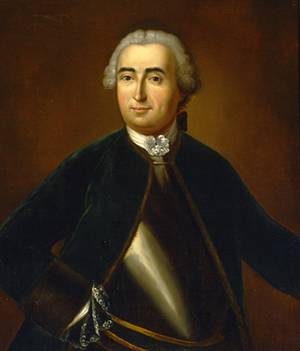
The official declaration of war followed almost a year later, in May, 1756, when in the New World blood flowed in broad streams. Louis-Joseph de Montcalme, an experienced military leader and participant in the Wars of the Polish and Austrian Successions, was appointed commander-in-chief of the French ground forces in Canada. He was a man with a fierce temperament, personal courage (for which he was awarded the highest award of France, the Order of Saint Louis in 1744), an uncompromising judgment - he was the exact opposite of the governor of New France, Pierre de Vodroy.
Vodrei frankly considered himself a great regional bosses and arrogantly treated army commanders. The fact is that, formally, New France, like its entire administration, belonged to the maritime department, and traditional inter-agency frictions were added to personal rivalry. For combat operations on such a vast territory, the French had very limited forces: at the beginning of the war, the governor and Moncalm had no more than 6 – 7 thousand regular army and several thousand armed militia-hunters - excellent fighters in the forest, but completely unprepared to the authorized field battle in the European manner. A great help for the French was cooperation with local Indian tribes. The British provoked indignation among the indigenous people with their unceremoniousness - the constantly growing English colonies forced, and often by force, the Indians to leave their own lands. There were fewer Frenchmen - they often intermarried with locals, used Indian techniques in hunting. Montcalm widely attracted his red-skinned allies to conduct combat operations against the British. New France largely depended on the metropolis, and the British fleet dominated the Atlantic, and therefore had to rely on local resources.
The beginning of the war in America was successful for the French. In August, 1756 Montcalm sent an expedition to Osuigo Fort, a British stronghold at the border, completely ruining it and destroying the large reserves stored there. Control of Lake Ontario was established, and the British colonies began to be subjected to massive attacks by Indians. The next year, 1757, a campaign was undertaken to capture the English Fort William-Henry, located on the shores of Lake George. The enemy’s energetic activities took the British by surprise - the British commander in America, Lord Laudon, was mediocre and inactive in every way, the governors of the colonies constantly littered and intrigued among themselves in matters of organizing the militia and supplying the army. The commander of the troops in the region, General Webb, too, was not distinguished by excessive bravery.
As a result, the 35 Infantry Regiment under the command of George Monroe had to rely on their own strength. Having exhausted all possibilities of resistance, 9 August 1757, the British agreed to an honorable surrender. Montcalm held explanatory conversations with the leaders of his Indian allies, but the locals had their own idea of the rules of war, and after the garrison left the fort, a massacre began, in which, according to various estimates, from 200 to a thousand people died. With great difficulty, the soldiers and officers of Montcalm managed to calm the Indians and stop the excesses. Subsequently, this particular episode inspired the writer Fenimore Cooper to create the best of his novels. The lack of troops (many disgruntled Indians went home, and part of the militia had to be released to harvest) did not allow the French to develop successfully launched offensive, and further penetration into the English colonies was decided to move to the next year.
However, external events inevitably and expectedly intervened in the course of internal events. Due to a number of miscalculations and the short-sightedness of Louis XV, the tumultuous activities of the Marquise de Pompadour, who helped her friend Maria Theresa in the fight against King Frederick, France was plunged into the war against Prussia on the side of Austria. This war and its attendant aid to the Austrian crown absorbed all the resources available to Versailles, albeit considerable,. Voltaire, with his usual witticism, remarked: "The union with Austria during 6 years cost France more money and people than all its wars against Austria over 200 years." At overseas theaters of war simply lacked the strength and capabilities. Louis XV bet on the wrong ace. Located off the coast of North America, the French squadron of Dubois de la Motte as part of 16 ships was forced to return to Europe because of the diseases started in the crews. The most battered ships were left in Louisburg.
There was also a change in England itself and not in the best direction for the French. William Pitt finally came to power and from a person whose opinion was heeded, became the navigator of British politics. He pointed out to those who doubted that the outcome of the war for Britain lay not only in the successes or failures of its Prussian ally, not in retaining Hanover, the patrimony of the English kings, but primarily in the complete destruction of the power of the French crown in America. Laudon was punished and replaced by energetic General James Abercrombie, to whom Pitt appointed Colonel Jeffrey Amherst to help him, who showed himself well in Germany and soon received the rank of major general. Substantial reinforcements were sent to America: about 12 thousand soldiers. The number of British squadrons in the local waters reached 23 battleships.
An attempt by the French to bring fresh troops to Montcalm to Canada failed — at the beginning of 1758, 8 ships with troops and various reserves, which were intercepted by the English squadron of Vice-Admiral Osborne, based in Gibraltar, and driven into Cartagena, left Toulon. Moncalm had to rely only on his own forces - no doubt, the British planned three military operations in Canada for 1758 a year.
The fall of Louisburg and the turning point in the campaign
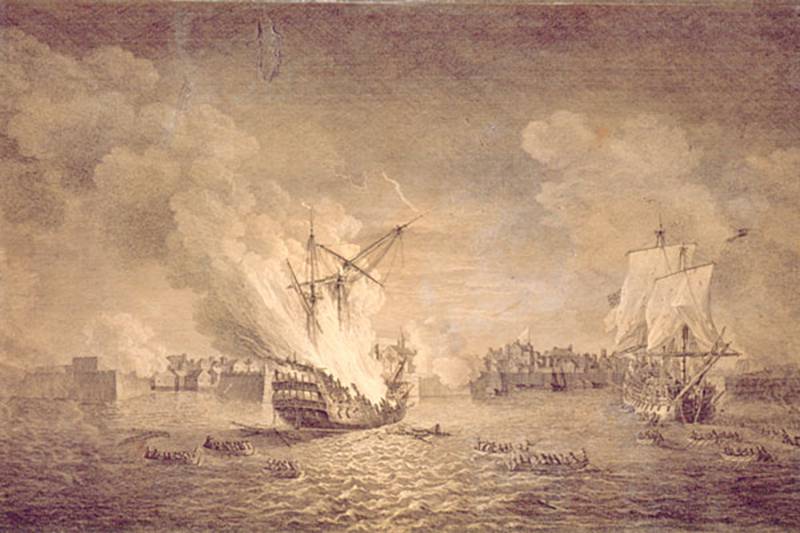
The first blow was directed against the French fort Duken in Pennsylvania, which was captured after fierce resistance. Abercrombie himself with a large by American standards army in 10 thousand soldiers and an impressive siege park (16 guns, 11 mortars and 3 howitzers) crossed Lake George and laid siege to another fort, Carillon (Ticonderoga). The usual vigor of the general in American realities let him down, and instead of quickly surrounding the French, he began to mark time. The ability to establish siege artillery at the commanding altitude (on the Mountain of Rattlesnakes) was also not realized. The passivity of the enemy allowed Moncalm to erect additional fortifications around Carillon, consisting of trenches fortified by earthen parapets and felled tree trunks.
Then Abercrombie made another mistake, which turned out to be fatal: he sent thousands of his soldiers to the French fortified positions in a close 7 formation, as if he hoped that the abundance of red jackets would cause the enemy to get frightened and raise the white flag. The French let the British cheerfully marching under “The British Grenadiers” closer to their own fortifications, and then opened fire. The losses were enormous - leaving more than 2 for thousands of dead and dying under the walls of Fort Carillon, the army of Aberkrombi hurried to evacuate by ships of the lake flotilla.
However, the main task of the British command was mastering Louisbourg. General Amherst landed with approximately 14 thousand soldiers on Cape Breton Island and began a systematic siege by the method of the Marquis de Vauban. Louisbourg was the strongest French fortress in North America, which was supposed to cover the Cabot Strait - from the penetration of British ships into the Gulf of Saint Lawrence. Louisbourg was the second largest French port in Canada and for its stone fortifications was nicknamed "Northern Gibraltar" and "American Dunkirk". The construction of this powerful fortress took 30 million livres. The defense complex was based on two large stone bastions, called “The King” and “Queen”, and on two smaller semi-bastions - “Dauphin” and “Princess”. The garrison of Louisbourg counted 6 with thousands of soldiers and sailors who had 100 guns. The British pulled the trenches closer and closer to the walls of the fortress, and by July 3 1758, General Amherst's troops were from Louisburg in 500 meters. British mortars regularly shelled the fortress, causing great damage to buildings inside the walls. In the nearby waters, the English fleet reigned supreme, the damaged ships in the harbor were abandoned by de la Motte and were permanently incapacitated. 26 July 1758. American Dunkirk capitulated. The gates to French Canada were open.
Quebec City
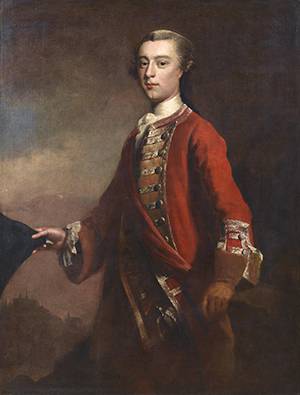
On 1759, the tireless Pitt planned to finally turn the inscription on geographical maps "French America" into an anachronism. All the necessary forces and capabilities for this were available. Abercrombie, who showed himself not in the best way at the walls of Carillon, was replaced by Amherst. Now the edge of the English sword had to pierce into the very heart of the possessions of the most Christian king in the New World - in Quebec. Fresh troops were sent across the ocean - almost 10 thousand people. The transport fleet was accompanied by a powerful squadron of Admiral Charles Saunders from the 23 battleships. The expedition was led by 31-year-old Brigadier General James Wolf. Like his main opponent, he was also an experienced military, a participant in the war for the Austrian legacy. During the suppression of the uprising of the Jacobites (supporters of King Jacob Stewart), Wolf categorically refused to take part in demonstration actions of intimidation, more simply referred to as massacres, for which he gained great respect from the Scottish soldiers who are in his submission.
The position of Moncalm by this time was far more bleak: behind the British expeditionary forces were the unrestrained energy of William Pitt and the resources of the empire, behind the Marquess there was only the petty miser and intriguer Governor Vodreuil, whose main benefit would be in his absence. Regular regiments, which were so difficult to redeploy from France, were constantly diluted due to losses by militias from the local population. The French logistical mechanisms increasingly faltered, which in the saddest way affected the provision with everything necessary. By the spring of 1759, the entire combat-capable population of the French colonies was put under the gun, which gave Montcalm 14 thousands of fighters, but the quality of most of them left much to be desired.
Quebec, though inferior in power to the fortifications to Louisbourg, was nevertheless a nutlet with a hard shell. The city towered on a rocky promontory, washed on three sides by the rivers St. Lawrence and St. Charles. The stone wall built in 1749 from one coast of the peninsula to the other had two significant drawbacks. First, there was no ditch in front of it (because of the rocky soil, this would require blasting), and in those places where the ditch was listed on paper, its role was performed by the 1,5 – 2-meter ditch. Secondly, the walls did not have any embrasures, and all the guns were vents on top of their crest. In addition, the fortress did not have an external belt of fortifications - as early as 1702, the French planned to build a couple of stone forts in Puen-Levi on the other side of the St. Lawrence River. Erection of batteries in this place would have allowed shelling of the city without difficulty, which later happened. Most of the resources allocated to fortification work in Canada, went to the construction of Louisburg and to improve the modest welfare of the gentlemen of the colonial administration. Construction of the forts in Puen-Levy was abandoned "out of economy". And as you know, saving on security leads to huge costs for subsequent inevitable sad events.
Montcalm, as he could, tried to increase the defense capacity of Quebec, using his limited resources. In the spring of 1759, the Wolf Army, concentrating in Louisbourg, was preparing to make a dash upstream of the St. Lawrence River. The northern bank of the river in the Quebec region is very high and steep. The French built a whole strip of fortifications here, called the Bopor Line, from the Montmorency Falls to the confluence of the St. Charles and St. Lawrence Rivers. Crews of small ships were brought ashore and strengthened the defense of the city. All in all, the French had 106 guns. There were several firewalls. The problem was that Montcalm did not have enough people for all the fortifications built.
9 June 1759 The British Armada entered the river. The 114 transports were carried by General Wolff's 10-thousandth army, accompanied by an 21 battleship. 26 June, the British landed on the island of Orleans near Quebec, where they set up their main camp. Two days later, the French launched their own firefighters on the British, on whom great hopes were pinned. However, set on fire prematurely, they produced an entertaining rather than effective effect - the British easily towed them to the shore, where they burned down. Admiral Saunders, commander of the naval component of the expedition, pointed out to Wolf the need to practice Puen-Levy, which, as mentioned above, the economical French did not even bother to strengthen. The general did not take long to persuade, and the British 29 June occupy this point. Soon, siege batteries are being built here, the presence of which greatly complicated the everyday life of the people of Quebec. Regular bombardments began - destruction in the city multiplied, fires became more frequent.
Despite the successes of the British, the dynamics of the operation slowed down, and its outcome remained uncertain. Storming the line of Bopor from the water was difficult - the shores were steep and rocky. To bypass the city and land southwest was considered impracticable by the English command - a high, steep bank framed the area in this area, known as the plain of Abraham. Moncalm, maneuvering with his own forces between different groups of fortifications, remained to hold out until late autumn, when the beginning of the storm season would force the enemy, whose entire logistics was tied to the St. Lawrence River, to go to capture Louisburg.
A tentative attempt to launch a raid against the redoubts of the Bópor line with the landing of one grenadier regiment in a place known as Point-Lassie led to failure and cost Wolfe nearly 500 dead, most of whom were Indians fighting on the French side. The English commander then began a war of attrition: special detachments ravaged and burned French villages along the banks of the river and around Quebec, which greatly hampered the supply of food to the city. Hunger has also been added to the regular bombardments. However, the last annoying circumstance did not concern Mr. de Vodrouille, who not only rolled up dinner parties for the elect, but also tried to give advice to Montcalm on how to fight correctly.
But soon, luck showed through the clouds her capricious face and smiled at General Wolf. It turned out that one of his officers, captain Robert Stab, was for some time in French captivity in Quebec, from where in the spring of 1759 he managed to escape. He told the general about the existence of a narrow and winding path leading from the shore to the plain of Abraham from the small cove of Anse du Foulon. The position of the British was unstable, and Wolf was ready to seize on any opportunity to achieve an early victory. Admiral Saunders was ordered to stage a demonstration against the Bópor Redoubts. On the morning of September 11, the English ships anchored and opened fire, lowering the boats, ostensibly to prepare the landing. Concerned, Montcalm pecked at this trick and sent here Colonel Bougainville (the one who would later become a famous traveler) with 1500 the best soldiers, mostly regular troops.
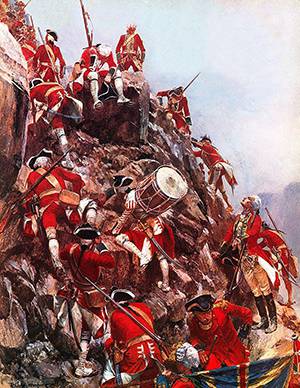
Meanwhile, Wolf, having collected a large number of boats and landed 1,5 thousands of soldiers on them, at nightfall 12 September 1759 began to move south-west, up the river. The British were paddling in almost total darkness — the French patrol hailed them twice, and the Scottish soldier who spoke French fluently twice in the ranks of the English responded. The French were misled, and in the dark they took the English boats for the food convoy, which was supposed to deliver supplies to the city. At 4 in the morning the English landed in the bay of Anse du Foulon. A small picket of the French militia, guarding the trail, was taken hostile by the grenadiers. By the morning on the plain of Abraham, it was almost 5 thousand British soldiers.
Moncalm, who had been awaiting enemy activity at Bopor all night, was taken aback. The enemy was practically at the walls of Quebec, and the walls, as already mentioned, did not have a moat. The French commander was in a dilemma. Or to attack with the available forces immediately - the governor wanted the units entering the garrison itself to remain in the city without fail, so that Montcalm had no more than 4,5 thousand soldiers at hand. Or he could wait for the return of the excellent soldiers of Colonel Bougainville, but they could return from the fortifications of Bopor only in the evening. Montcalm feared that during this time the enemy could build field fortifications near him, besides, provisions in Quebec remained for no more than two days. This last circumstance, obviously, played the main role in the decision of Moncalm to attack immediately. Two factors strongly influenced the course of the battle: first, the overwhelming majority of the French forces were irregular troops, not trained in organized combat; and, secondly, Montcalm had only two field guns (the naval leadership in the person of commandant de Rams did not provide any more, since “the guns were necessary for the defense of the city”).
The French attacked 13 September 1759 in 9 in the morning. The best troops attacked in the center: three battered regular regiments (700 men). Larger detachments of the militia and the Indians moved along the flanks. The British army was lined up by battalion, in two lines. Wolf ordered his infantry to lie down in order to avoid premature losses from the well-aimed riflemen of the enemy, and advanced forward his own skirmishers, mostly Scottish highlanders. Until about 10 hours, the battle developed in the form of a chaotic shootout - the French were approaching with a quick step. When the distance between the opponents was reduced to 200 steps, Wolf ordered the infantry to stand up and charge the muskets. Having let the enemy close, no more than 40 steps, the British team aimed an aimed volley, then another. These volleys not only produced terrible havoc in the ranks of the troops of Montcalm, but also turned them to flight. The superiority of the excellent training of regular troops over the poorly organized militia and numerous Indians, for whom field battles were unusual, had an effect.
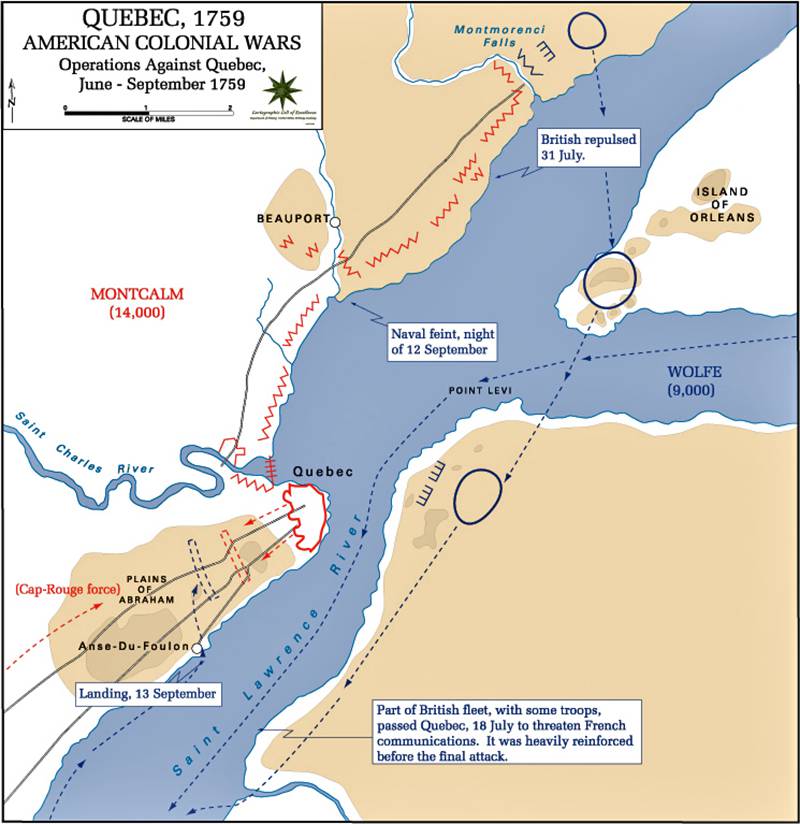
The fire of the French began to weaken, nevertheless, at this final stage of the battle, General Wolf was mortally wounded: two bullets pierced him right through. Having received a report that the enemy is fleeing, the general calmly remarked: "Thank God, now you can die peacefully." He soon died. His brave adversary, the Marquis de Montcalm, also did not escape the fatal bullet. Trying to stop the running subordinates with a bare sword, he was wounded, which turned out to be fatal. The wounded Marquis was taken to the city - 14 September 1759, he died. In the battle on the plain of Abraham, the French lost about 1200 killed, prisoners and wounded. The British also won a difficult victory: more than 600 Englishmen were killed and wounded from the accurate fire of the French riflemen and Indians. By the evening of September 13, Colonel Bougainville came to the city, and the French forces had an advantage. However, the death wound of Moncalm had a demoralizing effect on the army and the governor. General Townsend, who replaced Wolf, began to build field fortifications near the walls of Quebec. Bougainville brought the main part of the army out of the city and, crossing the river, began to retreat to Montreal. 18 September Quebec fell.
The fight for Canada continued after the fall of the capital of New France. Finally, the French were broken in 1760, when Montreal fell. 10 February 1763 was signed by the Paris Peace Treaty between England and France, under which the latter lost all its possessions in North America. The banner with the golden lilies of the Bourbons over the endless expanses of forests, rivers and lakes of Canada was forever lowered. The fortress of Louisburg, long empty and in a dilapidated state, was in the 1960s. restored by the initiative of the Government of Canada and a number of public organizations, and now this corner of royal France of the XVII century is a national park and a monument to that distant war.
Information